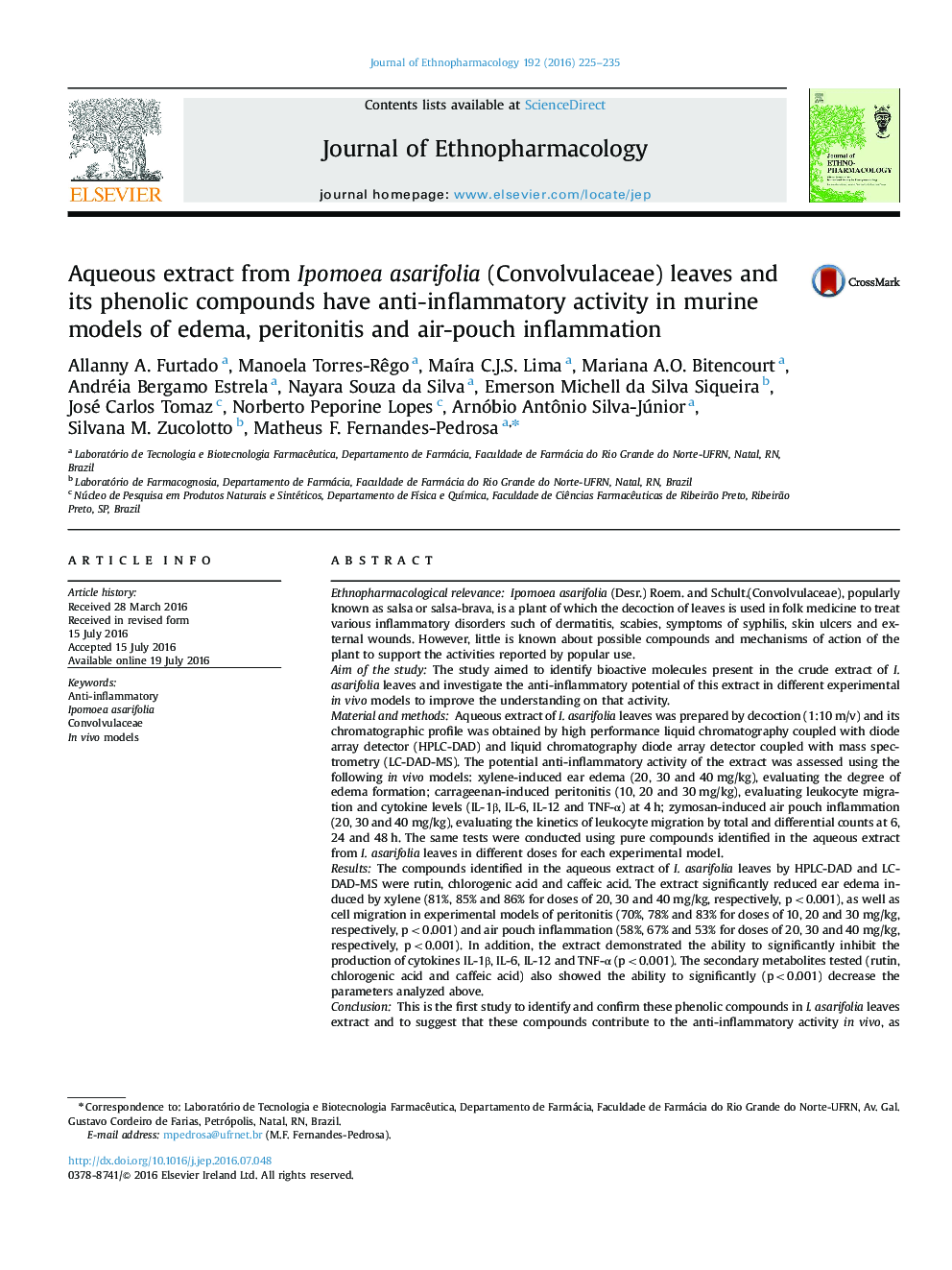| Article ID | Journal | Published Year | Pages | File Type |
|---|---|---|---|---|
| 2544550 | Journal of Ethnopharmacology | 2016 | 11 Pages |
Ethnopharmacological relevanceIpomoea asarifolia (Desr.) Roem. and Schult.(Convolvulaceae), popularly known as salsa or salsa-brava, is a plant of which the decoction of leaves is used in folk medicine to treat various inflammatory disorders such of dermatitis, scabies, symptoms of syphilis, skin ulcers and external wounds. However, little is known about possible compounds and mechanisms of action of the plant to support the activities reported by popular use.Aim of the studyThe study aimed to identify bioactive molecules present in the crude extract of I. asarifolia leaves and investigate the anti-inflammatory potential of this extract in different experimental in vivo models to improve the understanding on that activity.Material and methodsAqueous extract of I. asarifolia leaves was prepared by decoction (1:10 m/v) and its chromatographic profile was obtained by high performance liquid chromatography coupled with diode array detector (HPLC-DAD) and liquid chromatography diode array detector coupled with mass spectrometry (LC-DAD-MS). The potential anti-inflammatory activity of the extract was assessed using the following in vivo models: xylene-induced ear edema (20, 30 and 40 mg/kg), evaluating the degree of edema formation; carrageenan-induced peritonitis (10, 20 and 30 mg/kg), evaluating leukocyte migration and cytokine levels (IL-1β, IL-6, IL-12 and TNF-α) at 4 h; zymosan-induced air pouch inflammation (20, 30 and 40 mg/kg), evaluating the kinetics of leukocyte migration by total and differential counts at 6, 24 and 48 h. The same tests were conducted using pure compounds identified in the aqueous extract from I. asarifolia leaves in different doses for each experimental model.ResultsThe compounds identified in the aqueous extract of I. asarifolia leaves by HPLC-DAD and LC-DAD-MS were rutin, chlorogenic acid and caffeic acid. The extract significantly reduced ear edema induced by xylene (81%, 85% and 86% for doses of 20, 30 and 40 mg/kg, respectively, p<0.001), as well as cell migration in experimental models of peritonitis (70%, 78% and 83% for doses of 10, 20 and 30 mg/kg, respectively, p<0.001) and air pouch inflammation (58%, 67% and 53% for doses of 20, 30 and 40 mg/kg, respectively, p<0.001). In addition, the extract demonstrated the ability to significantly inhibit the production of cytokines IL-1β, IL-6, IL-12 and TNF-α (p<0.001). The secondary metabolites tested (rutin, chlorogenic acid and caffeic acid) also showed the ability to significantly (p<0.001) decrease the parameters analyzed above.ConclusionThis is the first study to identify and confirm these phenolic compounds in I. asarifolia leaves extract and to suggest that these compounds contribute to the anti-inflammatory activity in vivo, as reported by ethnomedicinal use of this plant. Through the different experimental models performed, we can conclude that the results obtained with the aqueous extract from I. asarifolia leaves support its popular use for the treatment of inflammatory disorders.
Graphical AbstractFigure optionsDownload full-size imageDownload high-quality image (304 K)Download as PowerPoint slide
